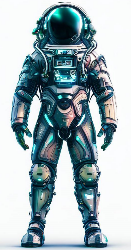Class-2 "Space Walk" Suit

This suit is designed in a nearly identicle way of the Class-1, except instead of all the layers being loose on eachother, they are designed to be tighter against the body for better movement for the wearer so that they are able to ensure they can perform their jobs as efficiently as possible. The cooling tubes on these suits are designed so that they are encased within trenchse of fabric close to the body.
The first test of this suit was in early 2023 during the preparations to disconnect the old Docking System from the Orbital Science Space Station, when the astronauts on the Space Station exited out to disconnect the primary electronic umbilicals to the docking system before the last Orbiter disconnected from the station. Other operations were conducted using the Class-2 Space Suit on the Orbital Science Space Station to repair equipment on the outside of the station, check the conditions of the on board RCS Thrusters to ensure they are operational for any adjustments to its orientation, and to ensure that slight meteor storms didn't damage any orbiters or cargo transports that were docked at the station. Throughout all of these operations, the Class-2 suit operated at peak efficiency and was proven to be a workhorse that ISA Astronauts can count on.
"The genius design of these suits made my job to disconnect the umbilicals easy and effective. A job, which would have taken nearly the entire time my suit was designed for, took less than half the time due to the easy movement and ability to grasp items efficiently."
Astronaut Jack Dlindro, Pilot of CRW-03 Mission

